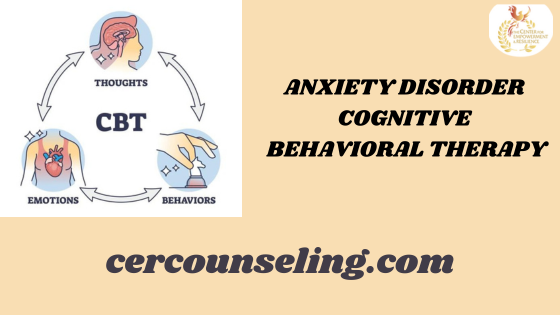Anxiety disorders are among the most common mental health issues today, affecting millions of people worldwide. Managing anxiety effectively often requires a multifaceted approach, with Cognitive Behavioral Therapy (CBT) emerging as one of the most effective treatments. At Cer Counseling, we believe in the power of CBT to provide lasting relief from anxiety disorders. Here, we’ll explore some of the top CBT techniques for managing anxiety and how they can help you regain control over your life.
Knowledge of Cognitive Behavioral Therapy
Cognitive Behavioral Therapy is a structured, time-limited psychotherapeutic approach that focuses on the interplay between thoughts, emotions, and behaviors. The core principle of CBT is that our thoughts influence our feelings and actions. By identifying and challenging negative or distorted thinking patterns, individuals can change their emotional responses and behaviors.
1. Identifying Negative Thought Patterns
One of the foundational techniques in CBT is identifying and challenging negative thought patterns. Many people with anxiety disorders experience distorted thinking that contributes to their feelings of worry and fear. These thoughts might include catastrophizing, overgeneralizing, or black-and-white thinking.
Technique: Keep a thought diary to record and examine your automatic thoughts. Whenever you experience anxiety, jot down the thought that triggered it. Evaluate the evidence for and against this thought and consider alternative, more balanced perspectives. This exercise helps break the cycle of negative thinking and reduces anxiety over time.
2. Behavioral Experiments
Behavioral experiments are designed to test the validity of negative beliefs and assumptions. By actively challenging these beliefs through experimentation, individuals can gather evidence that disproves their fears.
Technique: If you believe that you will embarrass yourself in social situations, plan a small social outing and observe the outcome. Reflect on whether your fears came true and what the actual experience was like. This technique helps reduce the power of irrational fears and builds confidence in managing anxiety-provoking situations.
3. Exposure Therapy
Exposure therapy is a CBT technique that involves gradual, controlled exposure to anxiety-provoking situations. The goal is to desensitize individuals to their fears and reduce avoidance behaviors.
Technique: Create a hierarchy of feared situations, starting with those that provoke mild anxiety and gradually working up to more challenging scenarios. Begin with the least anxiety-provoking situation and expose yourself to it in a controlled manner. Gradually increase the difficulty as you become more comfortable. This approach helps build resilience and reduces overall anxiety levels.
4. Cognitive Restructuring
Cognitive restructuring involves changing negative thought patterns into more realistic and balanced thoughts. This technique helps individuals challenge distorted thinking and adopt healthier perspectives.
Technique: Use a cognitive restructuring worksheet to identify a negative thought, evaluate its accuracy, and reframe it into a more balanced thought. For example, if you think, “I will fail at everything I try,” you might reframe it to, “I may not succeed every time, but I have succeeded before and can try again.” This process helps shift focus from negative outcomes to more positive and achievable goals.
5. Mindfulness and Relaxation Techniques
Mindfulness and relaxation techniques are essential components of CBT for anxiety. These techniques help individuals stay grounded in the present moment and reduce the physiological symptoms of anxiety.
Technique: Practice mindfulness meditation by focusing on your breath and observing your thoughts without judgment. Incorporate relaxation exercises, such as progressive muscle relaxation or guided imagery, to manage physical tension associated with anxiety. Regular practice of these techniques can enhance emotional regulation and overall well-being.
6. Problem-Solving Skills
Effective problem-solving skills can help manage anxiety by addressing the underlying issues that contribute to stress. CBT encourages individuals to develop practical strategies for solving problems rather than feeling overwhelmed by them.
Technique: Break down complex problems into smaller, manageable steps. Identify potential solutions and weigh the pros and cons of each. Develop an action plan and implement the chosen solution. This approach helps reduce feelings of helplessness and increases confidence in handling challenging situations.
7. Behavioral Activation
Behavioral activation is a CBT technique that focuses on increasing engagement in meaningful activities to combat depression and anxiety. By setting and achieving small goals, individuals can improve their mood and reduce anxiety.
Technique: Create a list of activities that you enjoy or find fulfilling. Schedule these activities into your daily routine and set achievable goals. For instance, if social interaction is challenging, start by scheduling short, manageable social activities and gradually increase their frequency. This technique helps build positive experiences and counteracts avoidance behaviors.
8. Relapse Prevention
Relapse prevention involves developing strategies to maintain progress and manage potential setbacks. It is crucial for sustaining the benefits of CBT over the long term.
Technique: Identify potential triggers or stressors that might lead to a relapse of anxiety symptoms. Develop a plan for addressing these triggers and implement coping strategies learned during therapy. Regularly review and update your relapse prevention plan to ensure ongoing success and resilience.
Cognitive Behavioral Therapy offers a robust set of techniques for managing anxiety disorders. By identifying and challenging negative thought patterns, engaging in behavioral experiments, and practicing mindfulness, individuals can gain greater control over their anxiety and lead more fulfilling lives. At Cer Counseling, our commitment is to support you through every step of your journey toward anxiety management and emotional well-being. If you’re struggling with anxiety, consider reaching out to us to explore how CBT can make a positive difference in your life.
